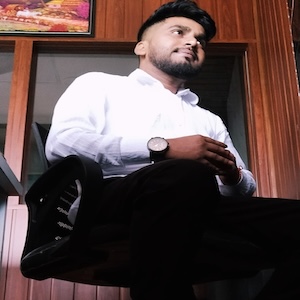SEBA Class 10 Weaving and Textile Design Chapter 3 Ornamentation of Fabric Solutions English Medium, SEBA Class 10 Weaving and Textile Design Question Answer, SEBA Class 10 Weaving and Textile Design Chapter 3 Ornamentation of Fabric Question Answer to each chapter is provided in the list so that you can easily browse throughout different chapter SEBA Class 10 Weaving and Textile Design Chapter 3 Ornamentation of Fabric English Medium Solutions and select needs one.
SEBA Class 10 Weaving and Textile Design Chapter 3 Ornamentation of Fabric
Also, you can read the SCERT book online in these sections Solutions by Expert Teachers as per SCERT (CBSE) Book guidelines. SEBA Weaving and Textile Design Elective Class 10 Question Answer. These solutions are part of SCERT All Subject Solutions. Here we have given SEBA Class 10 Weaving and Textile Design Chapter 3 Ornamentation of Fabric Solutions for All Chapter, You can practice these here.
Ornamentation of Fabric
Chapter – 3
| Self-Check Questions – 3 |
1. Define structural and decorative design.
Ans: (i) Structural design: In structural design, structure and design cannot be separated. The design is an integral part of the structure. If anything was taken away, it would not function. It is in its simplest form possible.
(ii) Decorative design: This is the surface enrichment of structural design. Any lines, colour, or materials that have been applied to structural design for the purpose of adding a richer quality to it constitute its decorative design. Decorative design on the fabric can be produced by weaving, embroidery/ stitching, printing etc. the ornamentation of surface leads to increase the value of the product.
2. Enlist the methods used in producing decorative design.
Ans: The methods used in producing decorative design are:
(i) Printing: Applying designs to fabric or other materials using various printing techniques.
(ii) Embroidery: Decorating fabric with needle and thread or yarn.
(iii) Painting: Applying paint to create unique, hand-painted designs.
(iv) Carving: Cutting into materials like wood, stone, or metal to create designs.
(v) Dyeing: Using color to create unique patterns and designs on fabric.
3. When and where do we use a dobby?
Ans: When the number of shafts to be controlled or the picks to a repeat of the design is beyond the range of tappet shedding, but is at the same time too small to be economically produced by a Jacquard, the dobby loom is used.
Uses: To produce stripes, checks, or designs of geometric character for dress materials.
4. State the function of the following accessories of a draw boy loom: Overheald, Phoni, Ring.
Ans: The function of the following accessories of a draw boy loom are as follows:
(i) Overheald: Overhalds are vertical cords connected with the sirash and warp threads. It is placed just at the back side of the ground heald. The ends of one dent is connected with one over heald to a single sirash. The overheald connections are done in accordance of the drafting of the design.
(ii) Pattern Former (Phoni): Phoni is a pattern forming unit which is produced in a wooden frame. In the phoni a pattern is prepared with required no of warp threads in the form of harness and required no of weft threads in ring form. The number of harness of the pattern former is depend upon the no of ends and drafting of the selected design. If the design is on straight draft the no of harness of the pattern former is equal to the no of ends of the design. On the other hand, if the design is on pointed draft the no of harness will be half plus one of the total no of ends of the design. The no of ring is depend on the no of picks (extra) of the design.
(iii) Ring: The ring is used to guide and manage the cords connected to the warp threads. It helps in keeping the cords organized and ensures smooth movement during the shedding process. It also helps the drawboy (assistant) identify and pull the correct set of threads for forming the pattern.
5. Which type of figuring is suitable by Draw boy loom?
Ans: The Drawboy loom is suitable for producing extra weft figuring designs, where additional weft threads are inserted selectively to create ornamental patterns over the ground weave. This type of figuring is commonly used in traditional handloom textiles such as chaddars, mekhela chadors, gamuchas, scarves, and sarees.
6. When and where do we use a Jacquard loom?
Ans: A Jacquard loom is used when highly intricate and large figured designs are required to be woven. It is a shedding device attached to the top of a handloom or power loom, designed to control a large number of individual warp threads independently. This allows the production of complex patterns without the limitations of traditional heald shafts.
The Jacquard mechanism was invented by Joseph Marie Jacquard in 1804. It operates using punched cards laced together in a continuous strip, with each card corresponding to one pick (weft insertion). This enables the loom to raise or lower specific warp threads to form detailed and decorative patterns.
Jacquard looms are widely used in the textile industry for producing decorative and elaborate fabrics, especially in home furnishings, upholstery, and fashion apparel. Common examples include brocade, damask, tapestry, brocatelle, and matelassé.
7. State any three comparisons between dobby and jacquard loom.
Ans: The three comparisons between dobby and jacquard loom are as follows:
(a) Design Complexity:
(i) Dobby Loom: Used for weaving small figured designs such as floral or geometric patterns, typically created by a combination of basic weaves. The designs are repetitive and simpler in structure.
(ii) Jacquard Loom: Can produce highly intricate and large designs using multiple weaves and colored yarns. The designs can be complex and varied, suitable for more elaborate decorative fabrics.
(b) Control of Warp Threads:
(i) Dobby Loom: Controls a limited number of warp threads, typically ranging from 6 to 48 heald shafts, with 16 to 20 shafts commonly used in industry.
(ii) Jacquard Loom: Controls individual warp threads separately and can handle a significantly larger number of warp threads, allowing for complex patterning on each thread, controlled by punched cards.
(c) Type of Fabrics Produced:
(i) Dobby Loom: Typically used for fabrics requiring smaller designs that are repeated throughout, such as chaddars, mekhela, gamuchas, and other traditional fabrics.
(ii) Jacquard Loom: Primarily used for producing elaborate and decorative fabrics, such as brocade, damask, tapestry, and matelassé, ideal for home furnishings and high-end apparel.
8. Write the uses of dobby loom.
Ans: The uses of dobby loom are:
(i) Production of Small Figured Designs: Dobby looms are ideal for weaving small figured designs (floral, geometric, etc.), where the patterns are repeated throughout the fabric. These designs are created using a combination of two or more basic weaves.
(ii) Control of Limited Number of Heald Shafts: Dobby looms can control 6 to 48 individual threads (heald shafts), making them suitable for fabrics that do not require extremely intricate patterning like the Jacquard loom. In practical applications, it controls 24 to 36 heald shafts depending on the material (cotton, wool, or allied fibers).
(iii) Medium Complexity Designs: Dobby looms are used for fabrics that have a weave repeat of 6 to 24 ends. This makes them suitable for medium complexity designs, which involve moderate control of warp threads.
(iv) Weaving of Fabric with Multiple Picks per Repeat: While the number of picks per repeat can be high (several hundred), dobby looms are more effective for controlling a lower number of picks, making them best suited for designs that do not require extensive control over large numbers of picks.
(v) Cost-Effective Production of Repetitive Patterns: Dobby looms are used to create repetitive patterns on fabrics, making them ideal for applications where patterns need to be woven across the fabric at a reasonable cost and complexity.
9. Name any four CATD software used for developing woven design.
Ans: Textronics, GC Kala Brahma, Ned Graphics, Viable.
10. Enlist the main parts of the Piano Card Cutter.
Ans: The main parts of a Piano Card Cutter are as follows:
(i) Cutting Blade: The primary component used for cutting the cards into desired shapes and sizes.
(ii) Blade Holder: Holds the cutting blade securely and ensures stability during the cutting process.
(iii) Base Plate: Provides a stable surface to place the cards for cutting.
(iv) Handle/Lever: Used to apply pressure to the blade for cutting. It can be manually operated or powered.
(v) Card Guide: Helps position and align the cards correctly for precise cutting.
(vi) Adjustment Knob: Allows for fine-tuning the blade height or cutting depth.
(vii) Feed Table: Supports the card stack and guides them towards the cutting area.
(viii) Pressure Plate: Holds the cards firmly in place while cutting to prevent movement.
(ix) Safety Guard: Protects the operator from accidental contact with the blade.
(x) Measurement Scale: Helps measure the length and width of the card being cut.
11. Name any five tie & dye techniques used in ornamentation of fabric.
Ans: Techniques of tie & Dye: There are many ways to tie the fabric for getting different effect. The tie and dyed fabric may be named as per their tieing techniques.
Some of the techniques are discussed here:
(i) Knotting: It is the simplest method of producing tie and dye designs. This produces somewhat circular hazy patterns without the use of any tieing material. Pick up the fabric at a point and make a firm knot. When this technique is used on a square material make a big knot in the centre and make knots at the corners.
(ii) Tiny Dots: This is the most widely used technique and is popularly known as bandhani work. Pick up little fabric and tie around three to four times to produce tiny dots. These dots may be lined of scattered or outlined into the shape of a design. The thread is generally carried from one tie to the other to speed up the work. Metal blocks with raised portions as per the design may be employed for design transfer.
(iii) Resist tying: To get even doted patterns, tie objects of the same size and shape. Insert the objects into the fabric and tie around. To produce variety objects of different shapes and sizes can be introduced.
(iv) Pleating: Pleating and tieing the fabric produces the stripes of various styles. For a straight stripe pattern, fold the fabric into tiny pleats either horizontally or vertically as per the direction of the stripes. Tie at intervals. If wider stripers are required, tie the thread covering wider space. For diagonal stripes, pleat the fabric diagonally and tie. Tieing and dyeing in different colours produce multi-colour stripes.
(v) Bundling: Folding and bundling fabric produce wide variety of designs. Fold the fabric in various ways- horizontally, vertically or diagonally into a square or a rectangle or a triangle. Tie vertically, horizontally and also tie the corners for geometrical patterns.
12. Name the resisting material used in batik printing.
Ans: The resisting material used in batik printing is wax.
(i) Wax: Bees wax is the best wax for batik for fine lines and small areas. This is rather expensive but more manageable and forms less cracks than other kinds. Rosin can be added in proportion of 1:4 of bees wax. Rosin is used if fewer cracks are required. For design areas, bees wax and paraffin.

Hi! my Name is Parimal Roy. I have completed my Bachelor’s degree in Philosophy (B.A.) from Silapathar General College. Currently, I am working as an HR Manager at Dev Library. It is a website that provides study materials for students from Class 3 to 12, including SCERT and NCERT notes. It also offers resources for BA, B.Com, B.Sc, and Computer Science, along with postgraduate notes. Besides study materials, the website has novels, eBooks, health and finance articles, biographies, quotes, and more.



